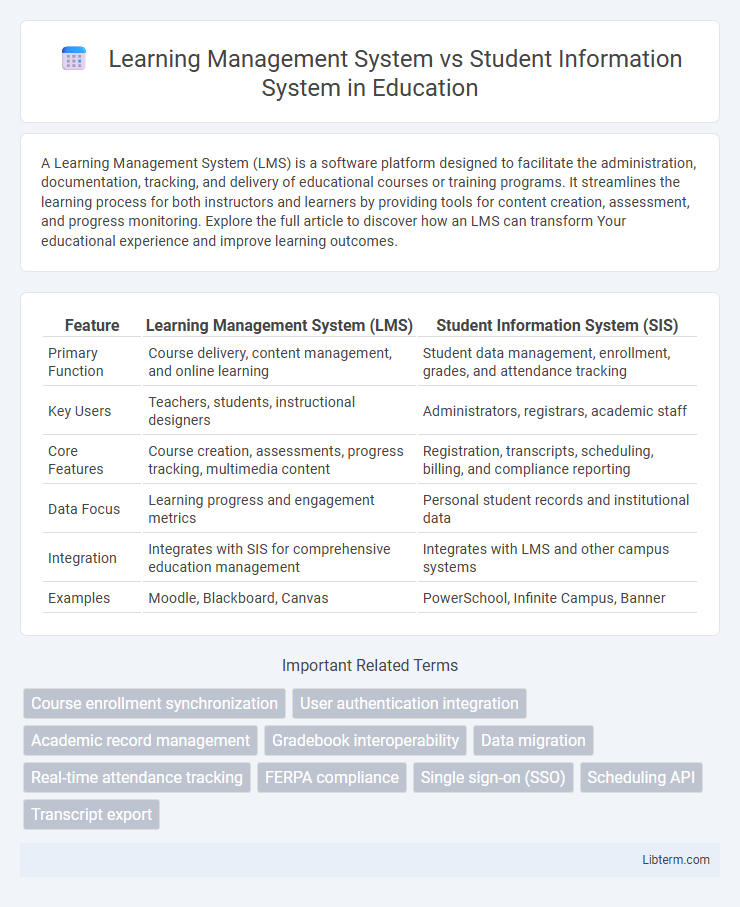A Learning Management System (LMS) is a software platform designed to facilitate the administration, documentation, tracking, and delivery of educational courses or training programs. It streamlines the learning process for both instructors and learners by providing tools for content creation, assessment, and progress monitoring. Explore the full article to discover how an LMS can transform Your educational experience and improve learning outcomes.
Table of Comparison
| Feature | Learning Management System (LMS) | Student Information System (SIS) |
|---|---|---|
| Primary Function | Course delivery, content management, and online learning | Student data management, enrollment, grades, and attendance tracking |
| Key Users | Teachers, students, instructional designers | Administrators, registrars, academic staff |
| Core Features | Course creation, assessments, progress tracking, multimedia content | Registration, transcripts, scheduling, billing, and compliance reporting |
| Data Focus | Learning progress and engagement metrics | Personal student records and institutional data |
| Integration | Integrates with SIS for comprehensive education management | Integrates with LMS and other campus systems |
| Examples | Moodle, Blackboard, Canvas | PowerSchool, Infinite Campus, Banner |
Introduction to LMS and SIS
A Learning Management System (LMS) is a digital platform designed for delivering, tracking, and managing educational courses and training programs, supporting interactive learning experiences and content organization. In contrast, a Student Information System (SIS) primarily handles administrative tasks such as enrollment, attendance, grades, and student records, facilitating efficient institution management. Both systems are essential in educational environments, with LMS focusing on instructional delivery and SIS managing student data and operational workflows.
Defining Learning Management Systems
Learning Management Systems (LMS) are software platforms designed to deliver, track, and manage educational courses and training programs, facilitating content creation, distribution, and learner assessment. They provide tools for interactive learning experiences, such as quizzes, discussion boards, and multimedia integration, aimed at improving student engagement and instructional efficiency. LMS platforms, including Blackboard, Moodle, and Canvas, differ significantly from Student Information Systems (SIS), which focus primarily on administrative data management like enrollment, grading, and attendance records.
Understanding Student Information Systems
Student Information Systems (SIS) are designed to manage comprehensive student data, including enrollment, grades, attendance, and demographic information, providing a centralized platform for academic administration. Unlike Learning Management Systems (LMS), which focus on delivering and tracking educational content and activities, SIS enables efficient data management and reporting for institutional decision-making. Integrating SIS with LMS enhances overall educational management by synchronizing student records with learning progress and administrative functions.
Core Features of an LMS
A Learning Management System (LMS) primarily focuses on delivering educational content, tracking student progress, managing assignments, and facilitating communication between instructors and learners. Core features of an LMS include course creation tools, assessment and grading modules, multimedia integration, and real-time analytics for monitoring learner performance. In contrast to Student Information Systems (SIS), which manage administrative data such as enrollment and attendance, LMS platforms provide an interactive and scalable environment tailored to online and blended learning experiences.
Key Functions of an SIS
Student Information Systems (SIS) are designed to manage comprehensive student data, including enrollment, attendance, grades, and transcripts, ensuring accurate record-keeping and compliance with educational regulations. They streamline administrative tasks like scheduling, reporting, and communication between staff, students, and parents. Unlike Learning Management Systems (LMS) that focus on course delivery and content management, SIS centers on academic and institutional data management to support student lifecycle management.
LMS vs SIS: Key Differences
Learning Management Systems (LMS) primarily facilitate online course delivery, content management, and learner engagement, while Student Information Systems (SIS) focus on managing student data, enrollment, grades, and administrative records. LMS platforms support instructional activities such as assignments, quizzes, and discussion forums, whereas SIS handles institutional operations including attendance tracking, transcripts, and scheduling. The key difference lies in LMS targeting the educational experience itself, and SIS emphasizing comprehensive student lifecycle management and data administration.
Integration Between LMS and SIS
Integration between Learning Management Systems (LMS) and Student Information Systems (SIS) streamlines academic data management by synchronizing enrollment, grades, and course schedules. This seamless data exchange enhances administrative efficiency and provides educators and students with up-to-date information across platforms. Robust APIs and middleware solutions enable real-time communication, ensuring consistent and accurate data flow between LMS and SIS environments.
Benefits of Using LMS and SIS
Learning Management Systems (LMS) enhance educational delivery by providing interactive tools for course management, real-time assessments, and personalized learning pathways, boosting student engagement and academic performance. Student Information Systems (SIS) streamline administrative tasks such as enrollment tracking, attendance monitoring, and grade reporting, improving institutional efficiency and data accuracy. Integrating LMS and SIS offers comprehensive benefits, combining effective instructional support with robust administrative management for an optimized educational experience.
Choosing the Right System for Your Institution
Choosing the right system for your institution requires evaluating key functionalities: a Learning Management System (LMS) focuses on course delivery, content management, and student engagement, while a Student Information System (SIS) manages enrollment, grades, attendance, and administrative data. Institutions must prioritize LMS platforms like Canvas or Moodle for interactive learning experiences, whereas SIS options such as PowerSchool or Infinite Campus provide comprehensive student record management. Integrating both systems ensures seamless communication between academic content and administrative processes, optimizing institutional efficiency and student success.
Future Trends in LMS and SIS Technologies
Emerging trends in Learning Management Systems (LMS) focus on artificial intelligence-driven personalized learning paths, immersive virtual reality classrooms, and advanced analytics for real-time learner engagement insights. Student Information Systems (SIS) are evolving toward cloud-native infrastructures with enhanced data interoperability standards, integrating biometric authentication and blockchain for secure credential management. The convergence of LMS and SIS through unified platforms harnesses machine learning to optimize academic advising, streamline administrative workflows, and support predictive student success models.
Learning Management System Infographic

 libterm.com
libterm.com